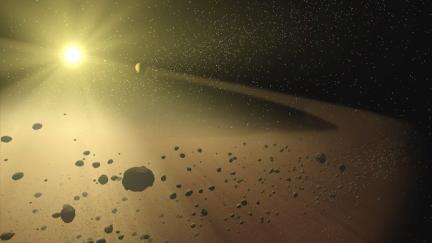Planet formation relied on sweeping up of small glassy beads, new model suggests

New research proposes that chondrules, small glassy beads that make up the bulk of the most primitive meteorites, played a crucial role in the formation of planets. Simulations developed by scientists at the American Museum of Natural History, Lund University in Sweden, and collaborating institutions show how asteroid-sized planetesimals—the building blocks of planets—can grow to observed sizes by sweeping up chondrules, each only about the size of a grain of sand. The work is published today in the journal Science Advances.
"The big question is, 'How did the planets come to be?'" said Mordecai-Mark Mac Low, a curator in the American Museum of Natural History's Department of Astrophysics and an author on the paper. "When the solar system first started forming, the largest solids were sub-micron dust. The challenge is to figure out how all of that dust was gathered up into planet-building objects that then formed the diversity of planets and other smaller bodies that we see today."
In the early stages of planet formation, dust particles in the disk of gas and dust surrounding a young star collide and stick together to form dust bunnies, then pebbles, then boulders. However, models of the disk show that the gas imparts a drag on boulders when these reach a size larger than a person, causing them to slow and eventually fall into the star after only about 100 orbits. In addition, fast-moving boulders break apart, rather than sticking together, when they collide.
In 2007 Mac Low and collaborators, including the lead author on the current work, Anders Johansen of Lund University, proposed a mechanism called the streaming instability, which predicts a different outcome. The streaming instability occurs when one orbit contains more boulders than its neighbors. Boulders moving in the same orbit and close to one another start sweeping the gas with them, which reduces the drag and thus the rate at which the boulders move inward, acting like the peloton that forms in a bicycle race. As boulders from orbits farther out enter this orbit, the density of boulders becomes so high that gravitational attraction causes them to collapse together into a planetesimal large enough to overcome gas drag.
In their latest work, Mac Low, Johansen, and their collaborators—Martin Bizzarro from the University of Copenhagen and Pedro Lacerda from the Max Planck Institute for Solar System Research—ran high-resolution simulations of the streaming instability using the European supercomputer network PRACE, with the goal of predicting the size distribution of the planetesimals produced by this mechanism.
"The access to some of the world's fastest supercomputers allowed us to perform simulations of planetesimal formation in exquisite detail," Johansen said. "We were able to measure the size distribution of the newly born planetesimals and compare this to the sizes of the asteroids in the solar system."
Current evidence suggests that asteroids reflect the original size distribution of planetesimals, because, as Mac Low says, "asteroids are essentially fossil planetesimals—ones that never got swept up into planet embryos."
So the researchers were surprised to find that the size distribution predicted by their simulations does not agree with the distribution observed in asteroids. In particular, the simulations did not produce enough large planetesimals.
The research team's focus next turned to chondrules, which make up about 50 percent of the mass of the most primitive meteorites (aptly called chondrites).
"The interesting thing about chondrules is that they're just the right size to get slowed down by the gas around planetesimals, which causes them to fall down and accumulate like sand piling up in a sandstorm," Mac Low said.
When the researchers accounted for the accretion of these glassy beads, they were able to reproduce the size distribution observed in asteroids. Their model also shows that larger planetesimals capture chondrules more easily, making them grow, become unstable in their orbits, and in some cases, collide with other planetesimals to build big planets like Mars and Earth or bigger objects like the cores of gas giants such as Jupiter.
The scientists are now eager to see more asteroid surface sampling and characterization studies, looking for the chondrule-rich crusts that could provide hard evidence for their theory.
More information: Science Advances 17 Apr 2015: Vol. 1 no. 3 e1500109 DOI: 10.1126/sciadv.1500109
Journal information: Science Advances
Provided by American Museum of Natural History


















